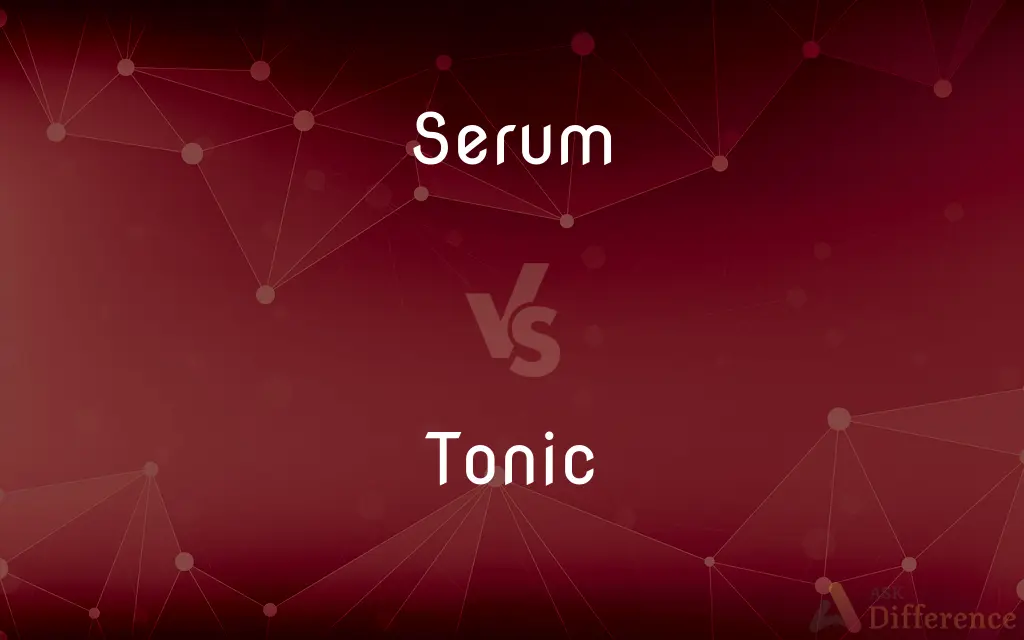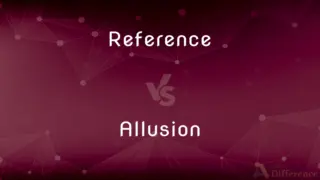Serum vs. Tonic — What's the Difference?
By Maham Liaqat & Urooj Arif — Updated on April 1, 2024
Serum is a skincare product designed to deliver high concentrations of active ingredients, targeting specific concerns, while tonic is a liquid product that cleanses, refreshes, and balances the skin's pH after cleansing.

Difference Between Serum and Tonic
Table of Contents
ADVERTISEMENT
Key Differences
Serum is formulated with smaller molecules to penetrate deeply into the skin, delivering a high concentration of active ingredients aimed at addressing specific skin issues like aging, hydration, or dark spots. On the other hand, tonic, often referred to as toner in skincare, acts primarily on the skin's surface to remove residual dirt, makeup, and cleanser, preparing the skin for the next steps in a skincare regimen.
While serums are used for their targeted treatment benefits and are applied after cleansing and toning but before moisturizing, tonics are used after cleansing to ensure the skin is clean and balanced. Tonics can also help to minimize the appearance of pores and restore the skin's pH balance, which can be disrupted during the cleansing process.
Serums are typically more expensive than tonics due to the high concentration of active ingredients and the research involved in their development. Meanwhile, tonics are considered a basic but essential part of daily skincare routines, offering hydration and skin-prepping benefits without the high cost.
The choice between serum and tonic depends on one's skin concerns and goals. Someone looking to combat specific skin issues might opt for a serum, while those focusing on maintaining clean, balanced skin might prefer a tonic. It's also common to use both in a complementary skincare routine, with the tonic preparing the skin for the serum's active ingredients.
Both products have evolved with the skincare industry, incorporating a variety of ingredients to cater to different skin types and concerns. For example, there are hydrating serums and tonics for dry skin, clarifying options for acne-prone skin, and formulas enriched with antioxidants for aging skin.
ADVERTISEMENT
Comparison Chart
Purpose
Delivers active ingredients to target specific skin concerns.
Cleanses, refreshes, and balances skin's pH.
Application
After toning, before moisturizing.
After cleansing, before serum and moisturizing.
Key Benefits
Targeted treatment for skin issues like aging, hydration, or dark spots.
Removes residual dirt, balances pH, and minimizes pores.
Consistency
Typically thicker than tonic, gel-like or liquid.
Watery liquid.
Cost
Generally more expensive due to high concentration of active ingredients.
Less expensive, considered a basic skincare necessity.
Ingredient Focus
High concentration of specific, active ingredients.
Ingredients that cleanse, refresh, and balance.
Compare with Definitions
Serum
A concentrated skincare product targeting specific concerns like aging.
The anti-aging serum reduced the appearance of her fine lines.
Tonic
Often contains hydrating ingredients.
The tonic was enriched with glycerin for extra hydration.
Serum
Formulated with high concentrations of active ingredients.
This serum contains vitamin C to brighten the skin.
Tonic
A liquid product that refreshes and balances the skin's pH.
She used a rosewater tonic to refresh her skin in the morning.
Serum
Often has a gel-like consistency.
The serum's gel-like texture felt lightweight on the skin.
Tonic
Used after cleansing to remove residual impurities.
The tonic removed traces of makeup left after cleansing.
Serum
Applied after toning and before moisturizing.
She applied her hydrating serum before her nightly moisturizer.
Tonic
Can help minimize the appearance of pores.
The witch hazel tonic visibly reduced the size of her pores.
Serum
Can penetrate deeply into the skin.
The serum's formula is designed to penetrate deeply and hydrate at the cellular level.
Tonic
Prepares the skin for moisturizers and serums.
Applying tonic helped her skin absorb the serum more effectively.
Serum
Watery fluid from animal tissue, such as that found in edema.
Tonic
An agent, such as a medication, that is supposed to restore or improve health or well-being.
Serum
Whey.
Tonic
A liquid preparation for the scalp or hair.
Serum
A watery liquid from animal tissue, especially one that moistens the surface of serous membranes or that is exuded by such membranes when they become inflamed, such as in edema or a blister.
Tonic
An invigorating, refreshing, or restorative agent or influence
Laughter was a tonic for the dispirited team.
Serum
(skincare) An intensive moisturising product to be applied after cleansing but before a general moisturiser.
Tonic
See tonic water.
Tonic
(Boston) See soft drink.
Tonic
(Music) The first note of a diatonic scale; the keynote.
Tonic
(Linguistics) A tonic accent.
Tonic
Restorative or stimulating to health or well-being.
Tonic
(Physiology) Of, relating to, or producing tone or tonicity in muscles or tissue
A tonic reflex.
Tonic
(Medicine) Characterized by continuous tension or contraction of muscles
A tonic convulsion or spasm.
Tonic
(Music) Of or based on the keynote.
Tonic
Stressed, as a syllable; accented.
Tonic
Pertaining to tension, especially of muscles.
Tonic
Restorative, curative or invigorating.
The arrival of the new members had a tonic effect on the team.
Tonic
In a state of continuous unremitting action.
Tonic
(music) Pertaining to or based upon the first note of a diatonic scale.
Tonic
Pertaining to the accent or stress in a word or in speech.
Tonic
Of or relating to tones or sounds; specifically being or relating to a speech sound made with tone unmixed and undimmed by obstruction, i.e. a vowel or diphthong.
Tonic
A substance with medicinal properties intended to restore or invigorate.
We used to brew a tonic from a particular kind of root.
Tonic
Tonic water.
Tonic
Any of various carbonated, non-alcoholic beverages; soda pop.
Tonic
(figuratively) Someone or something that revitalises or reinvigorates.
Tonic
(music) The first note of a diatonic scale; the keynote.
Tonic
(music) The triad built on the tonic note.
Tonic
(phonetics) A tonic element or letter; a vowel or a diphthong.
Tonic
To restore or invigorate.
Tonic
Of or relating to tones or sounds; specifically (Phon.), applied to, or distingshing, a speech sound made with tone unmixed and undimmed by obstruction, such sounds, namely, the vowels and diphthongs, being so called by Dr. James Rush (1833) " from their forming the purest and most plastic material of intonation."
Tonic
Of or pertaining to tension; increasing tension; hence, increasing strength; as, tonic power.
Tonic
Increasing strength, or the tone of the animal system; obviating the effects of debility, and restoring healthy functions.
Tonic
Characterized by continuous muscular contraction; as, tonic convulsions.
Tonic
A tonic element or letter; a vowel or a diphthong.
Tonic
The key tone, or first tone of any scale.
Tonic
A medicine that increases the strength, and gives vigor of action to the system.
Tonic
Lime- or lemon-flavored carbonated water containing quinine
Tonic
A sweet drink containing carbonated water and flavoring;
In New England they call sodas tonics
Tonic
(music) the first note of a diatonic scale
Tonic
A medicine that strengthens and invigorates
Tonic
Of or relating to or producing normal tone or tonus in muscles or tissue;
A tonic reflex
Tonic muscle contraction
Tonic
Employing variations in pitch to distinguish meanings of otherwise similar words;
Chinese is a tonal language
Tonic
Used of syllables;
A tonic syllables carries the main stress in a word
Tonic
Relating to or being the keynote of a major or minor scale;
Tonic harmony
Tonic
Imparting vitality and energy;
The bracing mountain air
Common Curiosities
How do I choose the right serum or tonic?
Choose based on your skin type and concerns; for hydration, look for ingredients like hyaluronic acid in serums and soothing components like aloe vera in tonics.
What is the main purpose of a serum?
The main purpose of a serum is to deliver high concentrations of active ingredients directly to the skin to address specific concerns.
Can serum replace my moisturizer?
No, serums are designed to treat specific skin issues and should be followed by a moisturizer to lock in hydration.
Can I use tonic without following with a serum?
Yes, tonic can be used on its own to cleanse and refresh the skin, even if you choose not to follow with a serum.
How does tonic fit into a skincare routine?
Tonic is used after cleansing to remove any lingering impurities, balance the skin's pH, and prepare it for the application of serum and moisturizer.
Can I use both serum and tonic in my skincare routine?
Yes, using both can be beneficial; the tonic can prepare your skin to better absorb the active ingredients in your serum.
Is tonic the same as astringent?
Not exactly; while both are used after cleansing, tonics are generally milder and hydrate, whereas astringents are stronger and primarily used to remove excess oil.
What are the signs that a serum is working?
Improvements in skin texture, clarity, hydration, or a reduction in specific concerns like dark spots indicate a serum is effective.
Why is serum generally more expensive than tonic?
Serum is more expensive due to its high concentration of active ingredients and the complex formulation process required to ensure deep skin penetration.
Do all skin types need serum?
While not a necessity for everyone, serums can benefit all skin types by addressing specific concerns more effectively than moisturizers alone.
How often should I use tonic in my skincare routine?
Tonic can be used twice daily after cleansing, in the morning and at night, to maintain clean and balanced skin.
Is tonic necessary for oily skin?
Yes, tonic can help remove excess oil, reduce shine, and minimize the appearance of pores, making it beneficial for oily skin types.
What makes a tonic hydrating?
Ingredients like glycerin, hyaluronic acid, and botanical extracts contribute to a tonic's hydrating properties.
How long should I wait to apply serum after tonic?
Wait until the tonic has fully dried, usually a minute or two, before applying serum to ensure optimal absorption.
How do I apply serum correctly?
Apply a few drops to clean, toned skin, and gently massage or pat until absorbed, avoiding pulling or stretching the skin.
Share Your Discovery

Previous Comparison
Reference vs. Allusion
Next Comparison
Fix vs. PutAuthor Spotlight
Written by
Maham LiaqatCo-written by
Urooj ArifUrooj is a skilled content writer at Ask Difference, known for her exceptional ability to simplify complex topics into engaging and informative content. With a passion for research and a flair for clear, concise writing, she consistently delivers articles that resonate with our diverse audience.














































